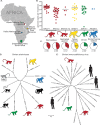Zoonotic Potential of Simian Arteriviruses
- PMID: 26559828
- PMCID: PMC4702702
- DOI: 10.1128/JVI.01433-15
Zoonotic Potential of Simian Arteriviruses
Abstract
Wild nonhuman primates are immediate sources and long-term reservoirs of human pathogens. However, ethical and technical challenges have hampered the identification of novel blood-borne pathogens in these animals. We recently examined RNA viruses in plasma from wild African monkeys and discovered several novel, highly divergent viruses belonging to the family Arteriviridae. Close relatives of these viruses, including simian hemorrhagic fever virus, have caused sporadic outbreaks of viral hemorrhagic fever in captive macaque monkeys since the 1960s. However, arterivirus infection in wild nonhuman primates had not been described prior to 2011. The arteriviruses recently identified in wild monkeys have high sequence and host species diversity, maintain high viremia, and are prevalent in affected populations. Taken together, these features suggest that the simian arteriviruses may be "preemergent" zoonotic pathogens. If not, this would imply that biological characteristics of RNA viruses thought to facilitate zoonotic transmission may not, by themselves, be sufficient for such transmission to occur.
Copyright © 2015, American Society for Microbiology. All Rights Reserved.
Figures

References
-
- Anthony SJ, Epstein JH, Murray KA, Navarrete-Macias I, Zambrana-Torrelio CM, Solovyov A, Ojeda-Flores R, Arrigo NC, Islam A, Ali Khan S, Hosseini P, Bogich TL, Olival KJ, Sanchez-Leon MD, Karesh WB, Goldstein T, Luby SP, Morse SS, Mazet JA, Daszak P, Lipkin WI. 2013. A strategy to estimate unknown viral diversity in mammals. mBio 4:e00598-13. doi:10.1128/mBio.00598-13. - DOI - PMC - PubMed
Publication types
MeSH terms
Grants and funding
- R01 TW009237/TW/FIC NIH HHS/United States
- T32 GM081061/GM/NIGMS NIH HHS/United States
- RR020141-01/RR/NCRR NIH HHS/United States
- P51 OD011104/OD/NIH HHS/United States
- P01 AI088564/AI/NIAID NIH HHS/United States
- R01AI084787/AI/NIAID NIH HHS/United States
- R01 AI116382/AI/NIAID NIH HHS/United States
- R01RR025781/RR/NCRR NIH HHS/United States
- P01AI088564/AI/NIAID NIH HHS/United States
- T32 AI055397/AI/NIAID NIH HHS/United States
- R01AI077376-01/AI/NIAID NIH HHS/United States
- T32 AI55397/AI/NIAID NIH HHS/United States
- C06 RR020141/RR/NCRR NIH HHS/United States
- C06 RR015459/RR/NCRR NIH HHS/United States
- P51 RR000167/RR/NCRR NIH HHS/United States
- RR15459-01/RR/NCRR NIH HHS/United States
- R01 OD010980/OD/NIH HHS/United States
- R01 AI084787/AI/NIAID NIH HHS/United States
- R01OD010980/OD/NIH HHS/United States
- R01 AI077376/AI/NIAID NIH HHS/United States
- HHSN272200700016I/AI/NIAID NIH HHS/United States
- P51RR000167/RR/NCRR NIH HHS/United States
- T32 GM008692/GM/NIGMS NIH HHS/United States
- TW009237/TW/FIC NIH HHS/United States
- R01RR016300/RR/NCRR NIH HHS/United States
- R01 RR016300/RR/NCRR NIH HHS/United States
- R01 RR025781/RR/NCRR NIH HHS/United States

